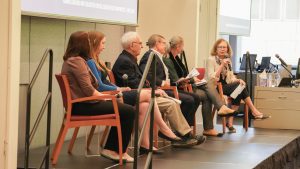- We found little opportunity to learn math in preK and kindergarten; children engaged in math content 4% of the day in preK and 9% of the day in kindergarten.
- Math instruction in preK and kindergarten largely focused on counting and cardinality.
- Kindergarten teachers repeated a majority of mathematics content from preK with no differentiation for student skill level.
How much mathematics instruction takes place in preK and kindergarten classrooms? Do kindergarten classrooms build on the math skills that children have already mastered, especially if they attended preK? In kindergarten classrooms with children of mixed skill levels, do teachers differentiate instruction and provide opportunities for children to build on what they know?
These are crucial questions. Early math skills are critically important for children’s long-term development and success in later grades. [2] Previous research has looked at what kindergarten teachers cover in their math instruction and how that content relates to children’s knowledge. The majority of these studies, however, relied on teachers’ self-reports of their content coverage. Few examined what kindergarten teachers actually do and even fewer looked at how their instruction connected with what children had learned in preK.
Based on observational data from preschool and kindergarten classrooms, our research demonstrates that there is relatively little math learning opportunity in either preK or kindergarten classrooms and that math content is highly redundant across those grades. Our findings also show that kindergarten students receive the same instruction, regardless of their entering skill levels in mathematics.
Our Research
Our study took place in a large southern city in the United States. We collected and analyzed observational data from 103 preK classrooms and 98 kindergarten classrooms at preK-5 public elementary schools serving low-income families. Researchers observed the preK classrooms for one full day in the spring of 2017 and administered a math assessment to the children (n= 455) at the end of their preK year. One day-long observation of the kindergarten classrooms took place in the fall of 2017. The kindergarten classrooms observed were spread across the district and each class enrolled at least five children with assessment data from the observed preK classrooms.
In kindergarten classrooms, we identified the preK children for whom we had collected math assessment data. The other children were observed anonymously. All children in the classroom were observed. The observational system is a snapshot approach where children and teachers are observed multiple times continually throughout the classroom day except during meals, outdoor time, and naps. Thus, we have good information on what individual children were focused on learning and can compare behaviors directly with skill levels.
What Math Topics Were Covered?
Our first question was to determine what mathematics content was covered in preK and kindergarten. We observed children engaged in math content 4% of the day in preK and 9% of the day in kindergarten. Within the general math focus, our observational system allowed us to examine the specific mathematics content being covered. Using the Common Core standards of mathematical content, the following table directly compares the content in both grades.
Table 1: Mathematical Content Observed in PreK and Kindergarten Classrooms

**Download a detailed version of Table 1 in PDF format.
The overwhelming conclusion from the data is the similarity in mathematics content across preK and kindergarten. In both grades, the majority of the mathematics content involved counting and cardinality. As shown in Detailed Table 1, there was little variation in the subcategorieswithin counting and cardinality; kindergarten children did a little less verbal counting and a little more counting objects and writing numerals. Also as shown in Detailed Table 1, kindergarten mathematics content focused more on adding and subtracting with and without numerals than preK content, though less time was spent on operations than on counting and cardinality. Neither measurement nor geometry received much attention in either grade.
A Closer Look at Counting and Cardinality
The below graph depicts the relationship between the average mathematics skill levels of the preK children in the kindergarten classroom and the amount of time that mathematics content focused on counting and cardinality. Researchers assessed children’s math skills at the end of preK with the Applied Problems subscale from the Woodcock Johnson Achievement Battery III (WJ-III), a frequently used standardized measure of math proficiency in children. At the end of preK, children’s average standard score on Applied Problems was very close to the typical score for 5 year olds. The range in scores was enormous with some children appearing gifted in math.
Graph 1: Amount of Time Mathematics Content Focused on Counting and Cardinality

There was a slight trend for classrooms with lower average student scores to focus more on counting and cardinality. But there were also classrooms where average student scores were higher and students still received that same content. For some classrooms with higher-skilled children, 100% of the math content focused on counting and cardinality.
Another way to examine possible differentiation is at the individual child level. The following table divides the children into four skill level groups and reports the percentage of counting and cardinality math content they engaged with based on our observations.
Table 2: Proportion of Math Content Focused on Counting and Cardinality by Pre-K Math Competence

Again, it is evident that much of the math content for higher-skilled children focused on counting and cardinality. Twenty-five children had WJ-III Applied Problems scores one standard deviation above the mean for the population, meaning they were in the top 15% of 4-5 year olds in the standardization sample. Yet these children spent more than two-thirds of their math learning time on rudimentary skills.
Differentiating Instruction by Skill Level
An argument against worrying about redundancy in preK and kindergarten is that teachers have to instruct a whole classroom in which only a few students might have attended preK. Given that the classrooms observed in this study all served low-income families who live in an area of the city with high rates of poverty, it is a plausible explanation.
But what could happen in kindergarten—and is supposed to happen—is differentiation among students so that higher-skilled students are exposed to more advanced content. Because of the way our observation system worked, we could examine the relation between individual student skill levels and the mathematics content each was given to work with. Our observations covered individual children in all learning situations. Children could have been given more advanced worksheets or activities that covered higher level content, and our system would have picked up on the differences.
As important as math is for all children, it is even more important for children from low-income families. [3, 4] Our research shows preK skills are not being built upon. Most children entering kindergarten have mastered verbal counting and cardinality even without preK. It is past time to increase the quality of the mathematics instruction we provide to children from low-income families in the primary grades.
[1] With much gratitude to Georgine Pion and Caroline Christopher who analyzed the data and to Tonya Lowe and Rachel Kasul who managed the data collection.
[2] Duncan, G. J., Dowsett, C. J., Claessens, A., Magnuson, K., Huston, A. C, Klebanov, P., et al. (2007). School readiness and later achievement. Developmental Psychology, 43, 1428-1446.
[3] Fyfe, E., Rittle-Johnson, B. & Farran, D.C. (available online). Predicting success on high stakes math tests from preschool math measures among children from low-income homes. Journal of Educational Psychology.http://dx.doi.org/10.1037/edu0000298
[4] Jordan, N. C., Kaplan, D., Ramineni, C., & Locuniak, M. N. (2009). Early math matters: kindergarten number competence and later mathematics outcomes. DevelopmentalPsychology, 45, 850-867. doi:10.1037/a0014939.



